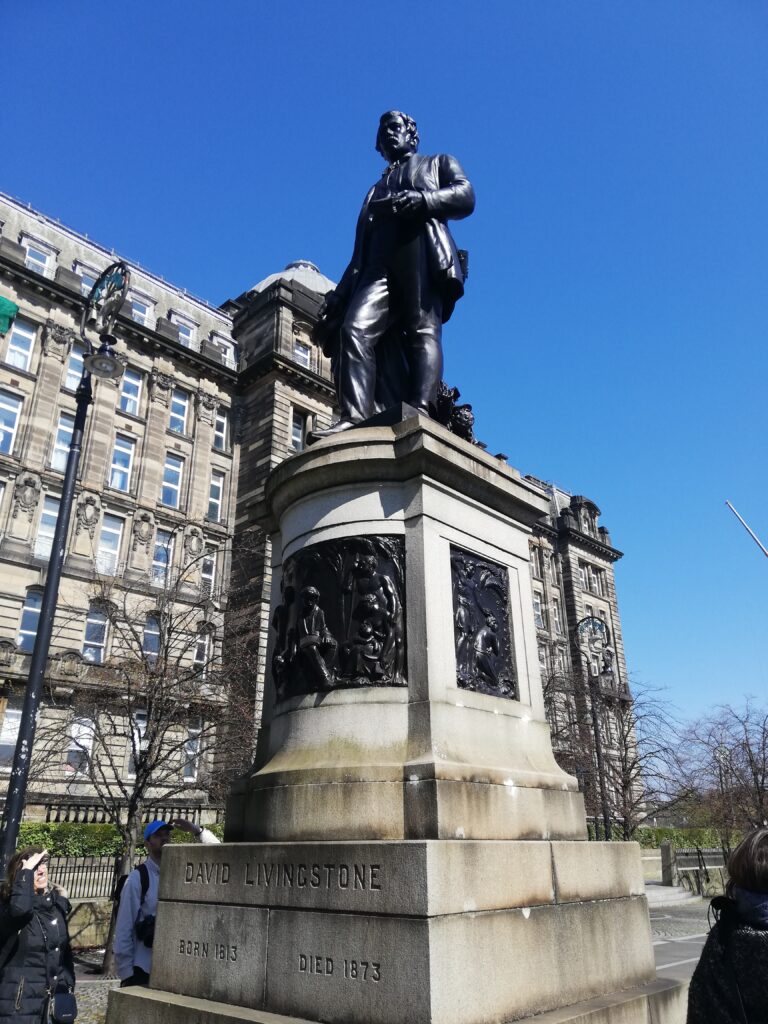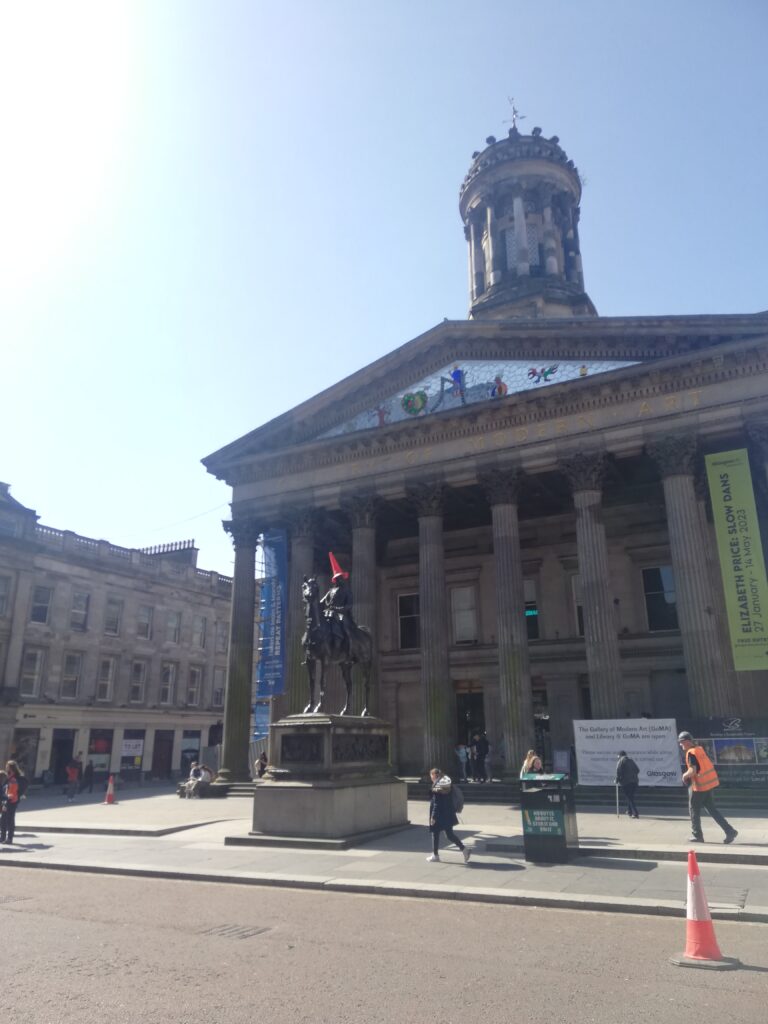Today’s blog comes from Collections Registrar Morven Rodger, reflecting on the 2023 ICOM UK Conference in Glasgow, addressing legacies of colonialism nationally and internationally.
In August 2018, while on a courier trip in Washington DC, I paid a visit to the National Museum of African American History and Culture1. In one of the very first galleries I entered, a label mentioning the Earl of Dunmore caught my eye…
‘In November 1775 Royal Governor of Virginia John Murray, the Earl of Dunmore, issued a proclamation that offered freedom to “all [indentured] servants, Negroes, or others… that are able and willing to bear arms” for the crown. But this promise was not fulfilled.’
I recognised the name immediately. John Murray, the 4th Earl of Dunmore, built the Pineapple, an architectural folly a stone’s throw from my hometown. I knew about the building, and the symbolic significance of the fruit, yet here I was, thousands of miles across the Atlantic, being offered a new perspective on this familiar figure. I remember being struck that I’d had to travel all this way to hear the other side of his story.
A lot has happened since 2018, and following the murder of George Floyd in 2020, the sector is increasingly working to address to the ongoing global impacts of slavery and colonialism. In September 2020 Zandra Yeaman became the first Curator of Discomfort at the Hunterian Museum in the same month as Glasgow Museums appointed their first Curator of Legacies of Slavery and Empire, a post now held by Nelson Cummins. In conversation with Paul Guardulo from NMAAHC, the three discussed strategies for Centring the enslaved and including perspectives from the global majority. The panel recognised the curatorial burden of this work but emphasised the ways this practice must permeate all areas of collections management, from enriching metadata to incorporating the cultural practices of source communities in the storage and handling of collections.
This was followed by a session on Interpreting and dismantling colonial education. As a child in Grenada in the ’50s and ’60s, writer Jacob Ross was still being taught from the Royal Reader, a series of 19th Century imperialist texts published by Edinburgh firm Thomas Nelson2. Ross spoke of the vast improvements to the Grenadian education system post-independence and the persistent gap between Britain’s understanding of its relationship with the Caribbean and the Caribbean’s conception of Britain. Lisa Williams of the Edinburgh Caribbean Association shared her work with teachers across Scotland, building the ‘emotional scaffolding’ to empower people to speak up and expand the curriculum to include the global impact of Scottish history. I was particularly interested to hear from Dr. Rianna Walcott from the University of Maryland, who co-founded Project Myopia in her time as a student at the University of Edinburgh. The below video was created by a third party and does not include closed captions or audio description.
In the third session, Working through climate and political crises while your home is being destroyed, curator Patricia Allan spoke about her experience working at Glasgow Museums while her loved ones in Ecuador continue to be endangered by earthquakes in the region. Climate and political crises are a conservation issue, as they result in the loss of material culture, communities and ecosystems, and relief efforts impose their own political agendas. Sahar Beyad from National Museum Liverpool contrasted the charitable response following the 2019 fire at Notre-Dame with that of the June 2022 earthquake in Afghanistan. On an interpersonal level, Shaheera Pesnani, Historic England, challenged us to show up for colleagues who are impacted by natural and man made disaster outwith the European community.
Finally, Professor Anthony Bogues joined us virtually from Brown University to share his thoughts on three exhibitions: The Abyss: Nantes’s Role in the Slave Trade and Colonial Slavery, 1707–1830, at the Musée d’histoire, Nantes, the Slavery exhibition at the Rijksmuseum and Afterlives of Slavery at Tropenmuseum, both in Amsterdam. All three exhibitions tackle the evils of slavery, but Professor Bogues sees a missed opportunity to draw a line between colonial slavery and present day anti-Black racism.
A visit to the @hunterian to see a lady taking tea in the Art Gallery, inspired me and Lola to discuss that wherever you are drinking tea, at work, in a cafe, or at home, it is wonderful to allow time to appreciate it! Go see all the amazing artworks and be inspired!! pic.twitter.com/Gkaqmr3yi5
— Zandra Yeaman (@zandrayeaman) April 27, 2023
On the second day, delegates were invited to tour the city’s museums. At the Hunterian Museum, Zandra Yeaman spoke again about her role Curating Discomfort, and the interventions made through the museum by a team of Community Curators. Across the road, in the Hunterian Art Gallery, Dr Lola Sanchez-Jauregui explained how a key work from the gallery’s collection, A Lady Taking Tea by Jean-Baptiste Siméon Chardin, serves as a gateway to explore the transnational impact of the British fashion for tea drinking. On display in the same gallery are still lifes demonstrating access to rare and ‘exotic’ produce, a portrait of an agent for the East India Company, examples of fine china produced in response to British tastes, and a sculpture edition by Christine Borland, a family grouping of bone china skulls with designs evoking colonial trade.

The statue of David Livingstone, Cathedral Precinct, Glasgow
After leaving the Hunterian, I joined the Black history city walk led by the Coalition for Racial Equality and Rights. The tour began at the statue of David Livingstone, cited by Dr Stephen Mullen in the Glasgow Slavery Audit. Livingstone was critical of the practice of slavery but continued to accept funding from cotton masters to pursue his explorations. Visible around the base of the statue in the image above are scenes of Livingstone’s missionary work (front) and an image of an enslaved man being struck with a lash (right). Despite such upsetting imagery, a campaign to resite the statue has so far been unsuccessful.
The tour continued to take in the Tontine Heads, followed by a stop on the original site of the University of Glasgow to learn about James McCune Smith, the first African American to earn a medical degree. The tour concluded outside the Gallery of Modern Art, which originally served as the mansion of tobacco and sugar merchant William Cunninghame. In front of GoMA stands an equestrian statue of the Duke of Wellington, mounted on a plinth depicting scenes of the Duke’s colonial suppression of India. It’s unclear whether this aspect of the Duke’s legacy persists in the public memory, but either way, this statue and its traffic cone topper have long been symbolic of the city’s disdain for its imperial forefathers.

The Duke of Wellington statue outside the Gallery of Modern Art, Glasgow
1 If you are interested in hearing more about NMAAHC and the development of their collection, I recommend A Journey to the ‘Blacksonian’ from NY Times podcast Still Processing, which features an interview with curator Joanne Hyppolite.
2 The publishing archive of Thomas Nelson & Sons Ltd can be found among the Rare Books and Archive collections of the University of Edinburgh.
